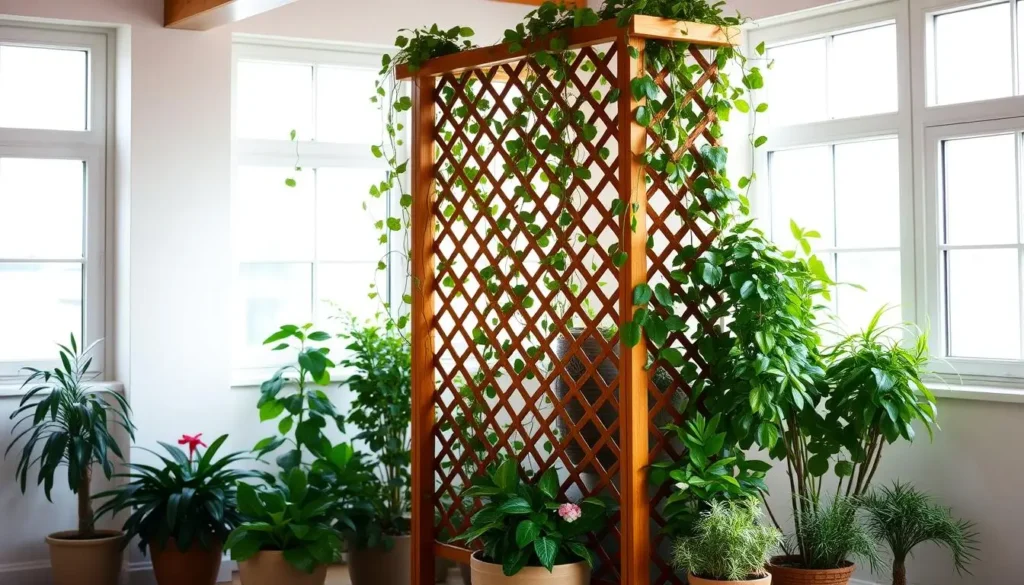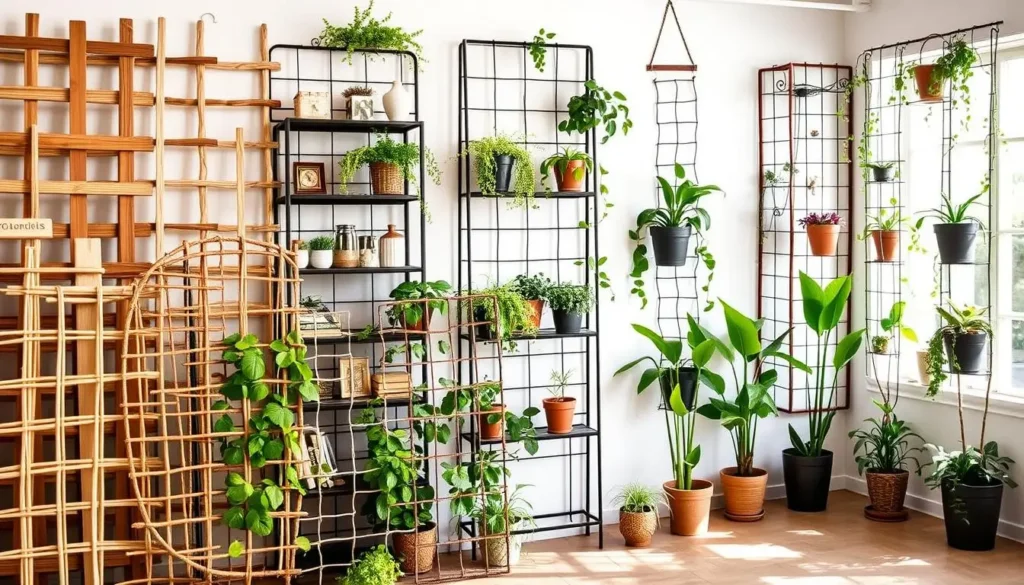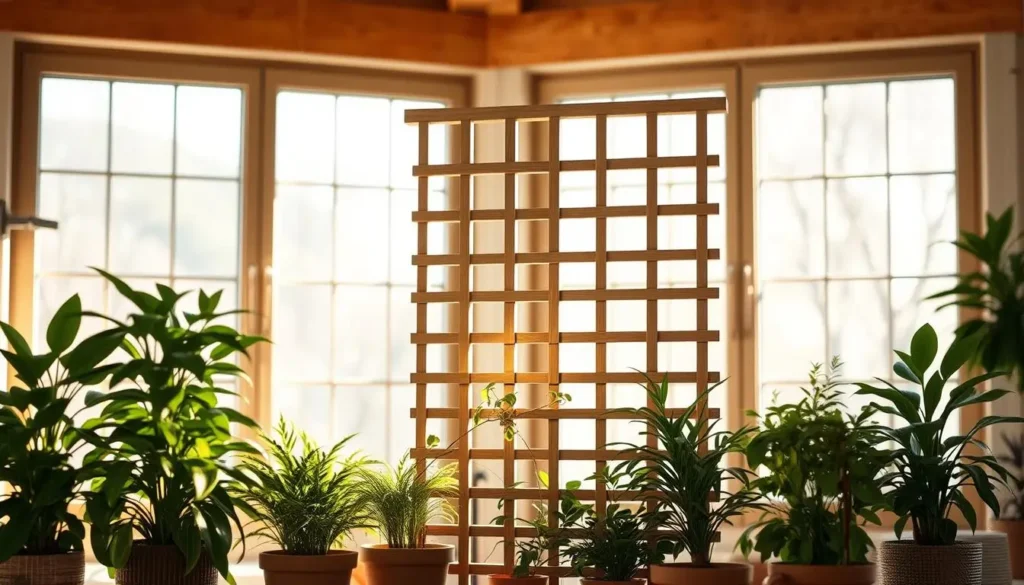Indoor Plant Trellis: Unlock the Secret to Lush Interiors.
Imagine walking into a room where your plants aren’t just sitting in pots. They’re reaching toward the light, their leaves cascading like living art. That’s the magic of an indoor plant trellis.
Whether your space is small or sprawling, a trellis turns ordinary greenery into a focal point. It’s more than support; it’s a way to let your plants thrive while lifting your home’s vibe.
Key Takeaways
- Indoor plant trellises enhance plant health and vertical growth.
- They maximize space in homes with limited floor area.
- Trellises add architectural interest to any room design.
- Proper support structures improve air circulation and light access for plants.
- Choosing the right trellis elevates both plant wellness and interior aesthetics.
What Is an Indoor Plant Trellis and Why Your Plants Need One
An indoor plant trellis is more than a pretty piece—it’s essential for your plants’ health. It guides climbing plants to grow up, just like they do in nature. This helps your indoor garden thrive.

The Science Behind Plant Support Structures
Plants stretch towards light because of phototropism. An indoor plant support helps them do this without getting weighed down. This keeps their roots safe and helps leaves grow evenly.
For instance, plants like monstera grow better when supported. Without a trellis, their leaves might rot on the floor.
Benefits of Trellises for Plant Health and Growth
- Improved airflow reduces mold risks
- Enhanced light absorption on all leaves
- Stronger stem development through guided growth
How Trellises Transform Your Indoor Garden Aesthetic
Using an indoor plant trellis turns your walls into stunning displays. It makes your space look amazing and saves room. You can choose from sleek metal or cozy wood, making your garden both beautiful and functional.
Types of Indoor Plant Trellises for Different Home Environments
Choosing the right indoor garden trellis depends on your home’s needs. Modern homes, cozy corners, or bright rooms each need something different. Here’s what you should know:

- Moss Poles: Great for plants that love humidity, like pothos or philodendrons. They soak up moisture, keeping roots healthy in humid places like bathrooms or kitchens.
- Bamboo Stakes: Light and natural, they fit well in bohemian or tropical settings. Ideal for trailing vines in living areas.
- Wire Mesh Trellises: Simple and strong, they suit modern lofts or offices. Their open design allows for good air flow.
- Expandable Frame Systems: These adjust as your plant grows. Perfect for small apartments where style is important but space is limited.
Think about your room’s light and humidity. A sunny window might need a strong wire frame for sun-loving plants. A dim basement, on the other hand, does well with a small lattice trellis. Match your trellis to your home’s style—metal for industrial or rattan for coastal. The best choice meets your plant’s needs and enhances your home’s look, making your trellis both useful and stylish.
Matching the Right Indoor Plant Trellis to Your Greenery
Choosing the right trellis is key for your plants to grow strong and fit well in your space. Here’s how to pick support that meets each plant’s needs:
Best Trellises for Pothos and Philodendrons
Pothos and philodendrons prefer to climb vertically. Go for a best indoor plant trellis with a moss pole or bamboo stake. These options let roots grip and climb naturally. For instance, a 12-inch moss pole provides structure without taking up too much space.
- Moss poles: Keep moisture for aerial roots
- Bamboo stakes: Light yet strong for delicate stems
Supporting Heavier Climbers: Monstera and Ivy
Monstera and ivy need sturdy support. Metal trellises or reinforced wire grids handle their weight as they grow. Place them in planters with wide bases to avoid tipping. Brands like Stairstep Trellis Co. offer strong options for heavy vines.
Miniature Trellises for Smaller Houseplants

For small plants, a small indoor trellis like a 4-inch wire frame or micro-moss stake is best. These small designs let baby plants climb without taking up too much space. Mini spiral trellises from GreenLife Supplies fit tiny pots perfectly.
- Mini moss sticks: Ideal for 4-inch pots
- Compact wire grids: Space-saving for desktop gardens
Pairing plants with the right trellis boosts growth and style. Match size, material, and growth patterns to keep your plants thriving.
DIY Indoor Plant Trellis Ideas: Crafting Custom Support for Your Plants
Transform everyday items into chic plant supports with these DIY ideas. You don’t need to buy expensive trellises. Repurposed materials and simple tools help you create ones that fit your style. Whether you prefer modern, rustic, or bohemian, these projects add both beauty and function.
Budget-Friendly Materials That Look Luxurious
Begin with cheap materials to make impressive trellises. Copper pipes from hardware stores create sleek designs. Driftwood from beaches or flea markets adds a natural touch. Bamboo skewers, wire, and thrifted frames can also be turned into supports.
Enhance these bases with spray paint, twine, or stones. This will make them look more luxurious.
Step-by-Step Guides for Three Easy Trellis Projects
- Copper Pipe Trellis: Bend ½-inch copper pipes into shapes like triangles or hexagons. Use pliers and zip ties to hold them together. Place in a pot or mount on a wall with L-brackets. It’s perfect for climbing plants like pothos.
- Driftwood Cluster: Set up three driftwood pieces in a tripod. Drill holes in the base and secure with a heavy planter. Use twine to guide climbing plants up.
- Recycled Frame Trellis: Take out the glass from an old picture frame. Weave twine across the frame. Hang it from a ceiling hook or lean it against a shelf.
Customizing Your Trellis to Match Your Décor
Personalize your trellis by changing finishes and colors. Paint metal with chalk paint for a modern look. Stain wood to match your furniture or add patterns with washi tape. Add seashells or windchimes for a tropical feel.
These small changes will make your trellis fit perfectly with your room’s style without spending more.
How to Install and Position Your Indoor Plant Trellis for Maximum Impact
Starting with stability is key for your indoor climbing plant trellis. First, make sure it’s firmly in the soil. This prevents it from wobbling. Choose a sturdy pot with good drainage to protect the roots.
- Put the trellis upright in the soil, leaving 3–4 inches at the bottom.
- Secure heavy trellises to walls or use heavy pots to keep them steady. This is important in areas with pets or kids.
- Adjust the trellis so vines can grow towards the light.
| Aspect | Tip |
|---|---|
| Light Access | Position the indoor climbing plant trellis near a bright window but avoid direct sun. |
| Seasonal Shifts | Move the trellis every three months to match sunlight changes, more so in winter. |
| Space Design | Use the trellis as a divider or screen for privacy in your living room. |
Turn your plant every two weeks for balanced light. Gently tie the stems to the trellis with twine to help them grow up. Check the trellis’s stability every month as the vines get thicker.
Decorative Indoor Trellis Options That Double as Home Décor
Turn your indoor garden into a stunning focal point with decorative indoor trellises. These pieces support climbing vines and enhance your room’s look. Each choice should balance plant support with style.
Metal Trellises: Modern and Minimalist Options
Metal trellises, like those made from powder-coated steel or oxidized copper, fit well in modern spaces. Look for designs with geometric patterns or industrial finishes. These add a modern touch without overpowering your decor.
Brands like West Elm and Urban Outfitters offer metal frames perfect for trailing plants. Choose matte black for a sleek look or polished brass for warmth.
Wooden Trellises: Natural and Timeless Appeal
Wooden trellises range from rustic driftwood to elegant stained oak. Cedar works well with natural colors, while walnut adds a touch of luxury. Slatted designs allow light to filter through, creating beautiful shadows.
Pre-finished options from Amazon Basics or World Market are stylish and affordable. They offer a great way to add wood charm to your space.
Statement Pieces: When Your Trellis Becomes Art
“A great trellis isn’t just a support—it’s a conversation starter.”
Make your trellis a standout with sculptural designs. Wire art from Etsy artisans or resin hybrids add drama. Vintage ironwork or gallery-wall inspired grids create a unique look.
These pieces remain eye-catching even when plants are sparse. They ensure your trellis is a focal point all year.
Choose materials that age well. Select finishes that look good with both empty frames and lush plants. This way, your trellis will always be a stylish addition.
Maintaining Plants on Your Indoor Climbing Plant Trellis
Setting up your indoor vine trellis is just the start. Regular care is key for your plants to flourish. Without it, they might become tangled or weak. Here’s how to keep your vertical garden looking great.
Training Techniques for Reluctant Climbers
Some plants don’t want to climb. Use soft twine or plant clips to gently guide them. Directional training means bending stems to grow upwards. For instance, wrap philodendron stems around trellis rungs for a natural look.
Pruning Practices for Balanced Growth
“Pruning is the language between you and your plant—it’s how you say, ‘grow here, not there.’” – Indoor Gardening Quarterly
- Trim overgrown vines with clean scissors to avoid damage.
- Pinch tips of leggy stems to stimulate branching.
- Remove dead leaves near the trellis base to improve airflow.
Seasonal Care Considerations
In winter, water less and skip fertilizers. Spring and summer are for more frequent feedings. Check for spider mites or scale insects on plants every month. Use neem oil if you find any.
Rotate pots seasonally to get even sunlight. Move the trellis as the seasons change to avoid burning your plants. A well-cared-for indoor vine trellis will keep your space lively all year.
Common Mistakes to Avoid With Your Indoor Vine Trellis
Stay away from these common errors to ensure your plants do well. Using a small trellis for fast-growing plants or a big one for small pots can harm growth. It’s also important to install the trellis at the right time to avoid problems.
- Material choices: Cheap plastic can bend under the weight of plants. Untreated wood may rot in damp places. Choose materials like coated wires or FSC-certified wood that breathe.
- Placement oversights: Putting trellises too close to walls can trap moisture and cause rot. Make sure there’s enough space for air to circulate.
- Attachment neglect: Tying vines too tight can hurt the stems. Check and loosen the ties every month as the plants grow.
“Improper pruning combined with poor trellis positioning causes 68% of plant failures,” reports the American Horticultural Society. Regular checks prevent irreversible damage.
Not keeping your trellis clean can attract pests like spider mites. Clean the surfaces with diluted neem oil every month to stop infestations. Also, don’t overcrowd plants on one trellis as it stresses the roots. Give each plant enough room to climb.
Making these mistakes can hurt both your plants and your decor. Focus on using durable materials, keeping enough space, and checking regularly to get the most out of your indoor trellis.
Conclusion: Elevating Your Indoor Garden With the Perfect Trellis
Choosing the right indoor plant trellis can transform your space. It’s not just about support; it’s about style and growth. Whether you’re growing a pothos or a monstera, the right trellis makes a difference.
Options range from metal and wood to DIY projects. These choices let you match your home’s look. Regularly train vines and prune for balanced growth. This makes vertical gardening a rewarding hobby.
Begin with a small trellis for succulents or go big for a bold look. Brands like Garden Trellis Co. and Leafy Living offer great options. But, repurposed materials can also work beautifully.
The goal is to find a balance between form and function. As your plants grow, so will your joy. You’ll see healthier plants and better air circulation.
As you get more confident, try new things in vertical gardening. Adjustable designs are perfect for changing with the seasons. Remember, proper care is key for lush results.
Investing in a good trellis is more than just support. It’s about creating a living art piece. Your plants and space will thank you for thoughtful vertical solutions.
FAQ
What is an indoor plant trellis?
An indoor plant trellis is a support for climbing plants. It helps them grow up instead of out. Trellises come in many styles, adding beauty to your garden.
Why do my plants need a trellis?
Plants need trellises to grow like they do outside. They get better air, light, and grow stronger stems. Trellises also stop problems like root rot and make plants look better.
What are the best indoor plant trellis options for small spaces?
For small spaces, choose mini trellises or wall mounts. Bamboo or wire frames are good because they save space. Vertical designs make your space look bigger and stylish.
Can I make a DIY indoor plant trellis?
Yes, making your own trellis is a fun way to add your touch. Use driftwood, bamboo skewers, or old furniture. It supports your plants and lets you be creative.
How do I install and position my indoor climbing plant trellis?
Put the trellis in the pot carefully to avoid harming roots. Place it where your plant gets the right amount of light. Make sure free-standing trellises are stable as plants grow.
What are common mistakes to avoid with my indoor vine trellis?
Don’t pick a trellis too small for your plants. Don’t wait too long to add a trellis. Use the right materials and place it right for best growth.
How do I maintain my plants on a trellis?
Check if your plants are climbing well and gently guide them. Prune them to keep them balanced. Watch for changes in seasons that affect their needs.
What are some decorative indoor trellis options?
You can find trellises in metal, wood, or as art. Choose sleek designs for modern looks or natural finishes for a rustic feel. They support your plants and add beauty to your home.
Can I use multiple trellis types for different plants in one space?
Yes! Mixing trellises can make your garden look good and work well. Just make sure each trellis fits the plant’s needs for the best growth and look.

